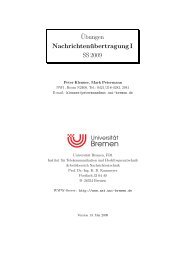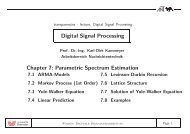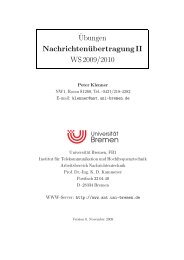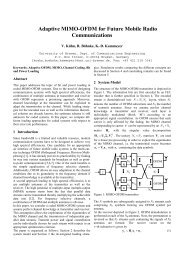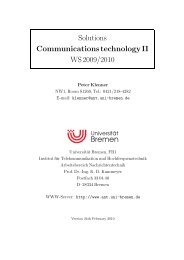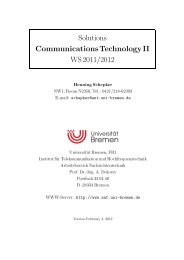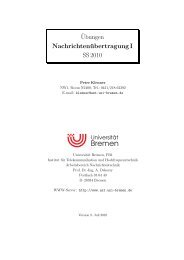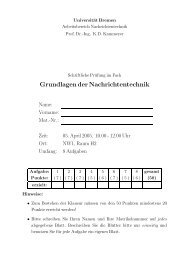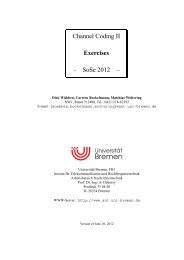Cell range expansion
Cell range expansion
Cell range expansion
You also want an ePaper? Increase the reach of your titles
YUMPU automatically turns print PDFs into web optimized ePapers that Google loves.
3G/4G Mobile Communications Systems<br />
Dr. Stefan Brück<br />
Qualcomm Corporate R&D Center Germany
2<br />
Chapter X: enhanced Inter <strong>Cell</strong> Interference<br />
Coordination in LTE<br />
Slide 2
3<br />
Enhanced Inter <strong>Cell</strong> Interference Coordination<br />
� The Next Deployment Step: Heterogeneous Networks<br />
� Traffic Offload and <strong>Cell</strong> Range Expansion<br />
� Interference Scenarios in Heterogeneous Networks<br />
� Enhanced Inter <strong>Cell</strong> Interference Coordination (eICIC)<br />
�� Almost Blank Subframes<br />
� X2 Coordination<br />
� Interference Cancellation Receivers<br />
� CRS, PSS/SSS, PBCH<br />
� Performance Gains of eICIC with IC receivers<br />
Slide 3
4<br />
Heterogeneous Networks<br />
� Network <strong>expansion</strong> due to varying traffic demand & RF environment<br />
� <strong>Cell</strong>-splitting of traditional macro deployments is complex and iterative<br />
� Indoor coverage and need for site acquisition add to the challenge<br />
� Future network deployments based on Heterogeneous Networks<br />
� Deployment of Macro eNBs for initial coverage only<br />
� Addition of Pico, HeNBs and Relays for capacity growth & better user experience<br />
� Improved in-building coverage and flexible site acquisition with low power base stations<br />
�� Relays provide coverage extension with no incremental backhaul expense<br />
Core<br />
Network<br />
Internet<br />
Backhaul<br />
HeNB<br />
Pico<br />
Pico<br />
Macro<br />
Relay<br />
Backhaul<br />
Pico<br />
Relay<br />
Slide 4
5<br />
Traffic Offloading from Macro to Pico Layer<br />
Pico<br />
Pico<br />
Macro<br />
SIR = 0 dB at cell edge<br />
of regular coverage area<br />
Pico<br />
SIR < 0 dB at cell edge of<br />
expanded coverage area<br />
� In homogeneous networks traffic is served<br />
by macro base stations<br />
� Deploying pico cells offers capacity gains by<br />
traffic offloading<br />
� Traffic offloading: UEs are preferably served<br />
by the pico cell rather than the macro cell<br />
� Advantages<br />
�� Better load balancing between macro and pico<br />
layer improves network capacity and user<br />
� How to achieve traffic offloading? Answer:<br />
<strong>Cell</strong> <strong>range</strong> <strong>expansion</strong> of the pico cell<br />
� The UE should connect to the pico cell even if<br />
the macro cell is stronger<br />
� Coverage area of the pico cell is artificially<br />
enlarged → <strong>Cell</strong> <strong>range</strong> <strong>expansion</strong><br />
Slide 5
6<br />
Downlink Interference Scenarios in HetNets<br />
� UEs in close proximity to CSG femto cells if UE is not allowed to connect to<br />
� This results in strong interference from the CSG cell<br />
Femto<br />
Macro<br />
Femto<br />
Femto is the<br />
aggressor and<br />
macro the victim<br />
� Macro-pico deployments with UEs operating in cell <strong>range</strong> <strong>expansion</strong><br />
� Nominally, a UE associates with a base station with strong DL SINR<br />
� With cell <strong>range</strong> <strong>expansion</strong>, a UE can associate with a low power eNB<br />
� The DL SINR can be much lower than 0 dB in cell <strong>range</strong> <strong>expansion</strong><br />
Pico<br />
Macro<br />
Pico<br />
Macro is the<br />
aggressor and<br />
pico the victim<br />
Slide 6
7<br />
eICIC in LTE Rel-10/11 – Concept<br />
� Enhanced interference management is needed to combat interference in<br />
HetNet co-channel deployments<br />
� Examples: CoMP, Coordinated Beamforming, eICIC<br />
� eICIC is introduced in LTE Rel-10 and further enhanced in Rel-11<br />
� eICIC = enhanced Inter <strong>Cell</strong> Interference Coordination<br />
� FeICIC = Further enhanced Inter <strong>Cell</strong> Interference Coordination<br />
� eICIC consists of three design principles<br />
� Time domain interference management (Rel-10)<br />
� Severe interference limits the association of terminals to low power cells<br />
� <strong>Cell</strong> <strong>range</strong> <strong>expansion</strong> (Rel-10/11)<br />
� Time domain resource partitioning enables load balancing between high and low power<br />
cells<br />
� Resource partitioning needs to adapt to traffic load<br />
� Interference cancellation receiver in the terminal (Rel-11/12)<br />
� Ensures that weak cells can be detected<br />
� Inter cell interference cancellation for control signals (pilots, synchronization signals)<br />
� Ensures that remaining interference is removed<br />
� Inter cell interference cancellation for control and data channels (PDCCH/PDSCH)<br />
Slide 7
8<br />
Almost Blank Subframes in eICIC (Rel-10)<br />
12 subcarrier of 15 kHz each<br />
1ms<br />
RS antenna port 1 resource element<br />
RS antenna port 2 resource element<br />
Empty PDSCH resource element<br />
Empty PDCCH/PHICH/PCFICH resource element<br />
� In Rel-10, almost blank subframes (ABS) have<br />
been introduced<br />
� In a ABS, no unicast PDSCH and PDCCH is<br />
transmitted<br />
� To ensure backward compatibility, following<br />
signals are transmitted<br />
� CRS (pilot signal)<br />
� PSS/SSS (synchronization signals)<br />
� SIB1/MIB (broadcast information)<br />
� CRS/PSS/SSS/SIB1/MIB can still cause strong<br />
interference in certain PRBs/REs<br />
Slide 8
9<br />
Interference Coordination in eICIC (Rel-10)<br />
Interference bitmap transmitted over X2 backhaul<br />
Statically assigned almost blank subframe<br />
Semi-statically assigned almost blank subframe<br />
Semi-statically assigned regular subframe<br />
Macro<br />
X2 backhaul link<br />
� Interference coordination between aggressor cell and victim cell is done by<br />
means of a bitmap sent over X2 interface<br />
� Each bit is mapped to a single subframe and indicates an ABS subframe<br />
� Based on the data traffic demand, the pattern can change each 40ms<br />
� <strong>Cell</strong> creating strong interference controls which resources can be used by the<br />
victim cell to serve terminals in harsh interference conditions<br />
Pico<br />
Slide 9
10<br />
Updates of the X2AP to support eICIC in Rel10<br />
� Information of ABS pattern is added to the ‘Load Indication’ procedure<br />
� The ABS pattern (40ms period for FDD) is sent from the aggressor to the victim<br />
� The ABS patterns are semi-statically updated<br />
� The ‘Load indication’ also contains an invoke indication<br />
� This indicator is sent from the victim to the aggressor to ask for eICIC activation<br />
IE/Group Name Presence Range IE type and<br />
reference<br />
Invoke Indication M ENUMERATED<br />
(ABS<br />
Information, …)<br />
Semantics description<br />
� Information about the status of the ABS is added to the ‘Resource Status<br />
Reporting’ procedure<br />
� Its initialization is enabled in the ‘Resource Status Reporting Initiation’ procedure<br />
� This information is sent from the victim to the aggressor<br />
IE/Group Name Presence Range IE type and reference Semantics description<br />
DL ABS status M INTEGER (0..100) Percentage of ABS<br />
resource allocated for<br />
UEs protected by ABS<br />
from strong inter-cell<br />
interference.<br />
� References:<br />
� R3-103667, “Introduction of X2 signaling support for eICIC”, TSG-RAN WG3 Meeting #70, November 2010<br />
� R3-103776, “Enabling reporting of ABS resource status for eICIC purposes”, TSG-RAN WG3 Meeting #70,<br />
November 2010<br />
–<br />
Slide 10
11<br />
Performance without IC Receivers (Rel-10)<br />
Pico<br />
Macro<br />
Pico<br />
SIR = 0 dB<br />
SIR = -6 dB<br />
(LTE Rel-10)<br />
We want much lower SIR → -18 dB!!<br />
� Capacity gains in HetNets are<br />
achieved by traffic offloading from<br />
macro to pico cells<br />
� Offloading is increased by cell <strong>range</strong><br />
<strong>expansion</strong><br />
� <strong>Cell</strong> <strong>range</strong> <strong>expansion</strong> increases<br />
footprint<br />
� SIR in expanded cell <strong>range</strong> < 0 dB<br />
�� ABS subframes allow serving UEs in<br />
expanded cell <strong>range</strong><br />
� However, interference from pilots and<br />
other control signals within ABS limits<br />
cell <strong>range</strong> <strong>expansion</strong><br />
� LTE Rel-10 supports cell <strong>range</strong><br />
<strong>expansion</strong> of SIR ≈ -6dB<br />
� Why only -6dB?<br />
� LTE Rel-10 assumes MRC & MMSE<br />
receivers, but no inter cell interference<br />
cancellation<br />
Slide 11
12<br />
Why IC Receivers are needed<br />
� Even in case of almost blank subframes at the aggressor nodes, the<br />
CRS/PSS/SSS/SIB1/MIB are still transmitted<br />
� PSS/SSS/MIB are always transmitted at the six middle PRBs in subframes #0 and<br />
#5 (FDD) → IC for PSS/SSS and PBCH<br />
� CRS are transmitted in each PRB in OFDM symbols #0, #4, #7, #11 → IC for CRS<br />
�� This interference from aggressor node causes significant performance<br />
degradation to data and control channels of serving cell<br />
� Therefore cancelling interference of CRS, PSS/SSS and PBCH is needed to<br />
enlarge cell <strong>range</strong> <strong>expansion</strong><br />
� Interference cancelation algorithms for those signals/channels can be<br />
designed that achieve SIR = -18 dB<br />
Slide 12
13<br />
Throughput Gains by CRS IC – Colliding RS<br />
Throughput Throughput (Kbps) (Kbps)<br />
6000<br />
5500<br />
5000<br />
4500<br />
4000<br />
3500<br />
3000<br />
2500<br />
2000<br />
1500<br />
1000<br />
500<br />
<strong>Cell</strong>ID0-TxMode3<br />
<strong>Cell</strong>ID0-TxMode3-<strong>Cell</strong>ID96-TxMode3-16dB<br />
<strong>Cell</strong>ID0-TxMode3-<strong>Cell</strong>ID96-TxMode3-IC-16dB<br />
CollidingRS-TxMode3<br />
9 dB Gain<br />
CRS IC Gains for<br />
colliding RS<br />
in non-MBSFN ABS<br />
0<br />
0 2 4 6 8 10 12 14 16 18 20 22 24 26 28 30 32<br />
Serving cell C/I (dB)<br />
Slide 13
14<br />
Throughput Gains by CRS IC – Non-colliding RS<br />
Thro Thro ughput ughput ( ( Kbps) Kbps)<br />
60 0 0<br />
55 0 0<br />
50 0 0<br />
45 0 0<br />
40 0 0<br />
35 0 0<br />
30 0 0<br />
25 0 0<br />
20 0 0<br />
15 0 0<br />
10 0 0<br />
5 0 0<br />
Ce l ID0 -T x Mo d e 3<br />
Ce l ID0 -T x Mo d e 3 -Ce l lID1 2 1 -T x Mo d e 3 -1 6 d B<br />
Ce l ID0 -T x Mo d e 3 -Ce l lID1 2 1 -T x Mo d e 3 -IC-1 6 d B<br />
N on c o l li d in g RS -T x Mo d e 3<br />
0<br />
0 2 4 6 8 1 0 1 2 1 4 1 6 1 8 2 0 2 2 2 4 2 6 2 8 30 3 2<br />
S e rv i ng c e l l C/I (d B )<br />
3.5 dB Gain<br />
CRS IC Gains for<br />
Non-colliding RS<br />
in non-MBSFN ABS<br />
Slide 14
15<br />
Reliability of PBCH with PBCH IC (Rel-11)<br />
SINR = -18 dB<br />
Slide 15
16<br />
User Association w/ and w/o <strong>Cell</strong> Range Expansion<br />
� The figure shows the percentage<br />
of UEs connected to the pico cells<br />
� Uniform Layout: UEs uniformly<br />
distributed across the macro cell<br />
� Hotspot Layout: 2/3 of the UEs<br />
located within 40m radius of the<br />
pico cells<br />
� Rel-8 Association: UEs<br />
connected to the strongest cell<br />
� Tx power difference between macro<br />
and pico impacts association<br />
� Range Expansion: UEs<br />
connected to the cell with minimal<br />
path loss<br />
� Tx power difference between macro<br />
and pico does not impact<br />
association<br />
Slide 16
17<br />
eICIC Performance with IC Receivers – I/II<br />
Rel-10 Rel-11<br />
70% Gain<br />
62% Gain<br />
� Simulation Assumptions<br />
� ITU UMa for macro, ITU UMi for pico<br />
� 2x2 antenna configuration (TM4)<br />
� Hotspot scenario with four pico cells<br />
per macro cell randomly placed<br />
� 2/3 of the UEs located within 40m<br />
radius of the two pico cells<br />
� User arrivals follow Poisson process<br />
� 1 Mbytes download file size<br />
� <strong>Cell</strong> <strong>range</strong> <strong>expansion</strong> of SIR = -12<br />
dB by CRS/PSS/SSS/PBCH IC<br />
� Served throughput = total amount of<br />
data for all users / total amount of<br />
observation time / number of cells<br />
� Gains up to 62% at 50% load<br />
achievable by aggressive cell <strong>range</strong><br />
<strong>expansion</strong> and advanced receivers<br />
on top of Rel-10 HetNets<br />
Slide 17
18<br />
eICIC Performance with IC Receivers – II/II<br />
70% Gain<br />
� Simulation Assumptions<br />
� Hotspot scenario with four pico cells<br />
per macro cell randomly placed<br />
� 2/3 of the UEs located within 40m<br />
radius of the two pico cells<br />
� User arrivals follow Poisson process<br />
� 1 Mbytes download file size<br />
� <strong>Cell</strong> <strong>range</strong> <strong>expansion</strong> of SIR = -12<br />
dB by CRS/PSS/SSS/PBCH IC<br />
� Served throughput = total amount of<br />
data for all users / total amount of<br />
observation time / number of cells<br />
� Gains up to 70% at 50% load<br />
achievable by aggressive cell <strong>range</strong><br />
<strong>expansion</strong> and advanced receivers<br />
Slide 18
19<br />
Summary and Outlook<br />
� Heterogeneous Networks are a cost effective approach to significantly<br />
enhance capacity of LTE cellular networks<br />
� Macro cells ensure broad coverage and low power nodes in hotspots provide<br />
additional capacity<br />
� Three design features are crucial for Heterogeneous Networks<br />
� Interference management as severe interference limits the coverage area of low<br />
power nodes<br />
� <strong>Cell</strong> <strong>range</strong> <strong>expansion</strong> through adaptive resource partitioning as it enables traffic<br />
load balancing between high and low power cells (traffic offloading)<br />
� Interference cancellation receiver in the terminal as it ensures that weak cells<br />
can be detected and remaining power can be removed<br />
� All three components together are needed to exploit the full potential of<br />
heterogeneous networks<br />
� Improving eICIC further is one of the big topics in Rel-11 in RAN1 and RAN4<br />
� The target is a cell <strong>range</strong> <strong>expansion</strong> of 9 dB with IC receivers in Rel-11 (FeICIC)<br />
Slide 19



